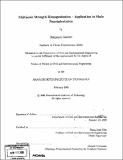Multiscale strength homogenization : application to shale nanoindentation
Author(s)
Gathier, Benjamin
DownloadFull printable version (17.37Mb)
Other Contributors
Massachusetts Institute of Technology. Dept. of Civil and Environmental Engineering.
Advisor
Franz-Josef Ulm.
Terms of use
Metadata
Show full item recordAbstract
Shales are one of the most encountered materials in sedimentary basins. Because of their highly heterogeneous nature, their strength prediction for oil and gas exploitation engineering has long time been an enigma. In this thesis, we propose a two-scale non-linear procedure for the homogenization of their yield design strength properties, based on the Linear Comparison Composite Theory. At Level 0, the intrinsic friction of shales is captured via a cohesive-frictional strength criterion for the clay particles (Drucker-Prager). Level I is composed of a porous clay phase and Level II incorporates silt and quartz grains. Homogenization yields either an elliptical or an hyperbolc strength criterion, depending on the packing density of the porous clay phase. These criteria are employed in an original reverse algorithm of indentation hardness to develop hardness-packing density scaling relations that allow a separation of constituent properties and volume fraction and morphology parameters, including interface conditions between the porous clay matrix and the (rigid) silt inclusions. The application of this algorithm to 11 shale samples from the GeoGenome project data base allows us to identify: (i) an invariant value of the solid hardness of clay particles, which is independent of clay mineralogy, porosity, etc.; and (ii) shale independent scaling relations of the cohesion and of the friction coefficient with the mean clay packing density, which provides some evidence that the elementary building block of shale is a clay polycrystal. The use of these scaling relations in the Level II-homogenization provides a first-order model for the prediction of the macroscopic strength properties of shale, based on only two parameters that delineate shale's macroscopic diversity: clay packing density and silt inclusion volume fraction.
Description
Thesis (S.M.)--Massachusetts Institute of Technology, Dept. of Civil and Environmental Engineering, 2008. Includes bibliographical references (p. 236-246).
Date issued
2008Department
Massachusetts Institute of Technology. Department of Civil and Environmental EngineeringPublisher
Massachusetts Institute of Technology
Keywords
Civil and Environmental Engineering.